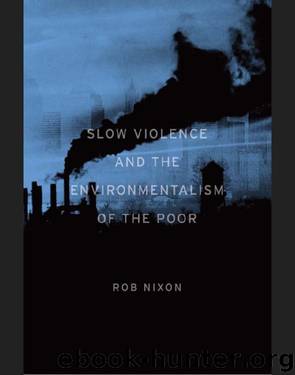Slow Violence by Rob Nixon

Author:Rob Nixon
Language: eng
Format: epub
Publisher: HarvardUniversityPress
Published: 2011-10-17T16:00:00+00:00
Roy thus turns to the essay as a form that, in temporal and sensory terms, holds the promise of the immediate, of a quick, inhabited retort to the unimaginable—and unimaginative—culture of the colossus. In this spirit, she calls for an art committed to undoing verbally and bureaucratically inflicted absence: “[A]n art that makes the impalpable palpable, makes the intangible tangible, and the invisible visible. An art which can draw out the incorporeal adversary and make it real. Bring it to book.”41
In bringing to book the deadly, long-distance administration of living rivers via the silted language of the hydro-bureaucrat’s report, Roy repeatedly returns to questions of narrative monopoly. The shrinking of knowledge to expertise and the centralizing of power—not least the power to tell—renders us unsighted, making it harder to inhabit the lived consequences of neoliberalism’s densely rationalized developmental narratives.
Roy’s vocal tactics, by contrast, are expressly decentered. There’s a productive instability to her voice that keeps her audience off balance. She belongs, in that sense, to the tradition of the lyric essay as environmental polemic, a tradition that includes figures as diverse as Edward Abbey and Jamaica Kincaid. All of them are cantankerous, rowdy, irreverent, but also by turns tenderly specific, interspersing a lyricism of the sentence and a lyricism toward living forms with blasts of sarcasm, parody, hyperbole, vehemence, and blunt anger. All three writers are exponents of what Raymond Williams called “militant particularism,” but all are equally exponents of the calculated overgeneralization. In the process, they jettison any ambition of directing the essay’s formal possibilities toward building a quiet, readerly rapport, far less universal admiration. By seceding from what one might call the emotionally miniaturist tradition of the essay, Roy, Abbey, and Kincaid explode the form with outsize sentiments directed at outsize adversaries: developers, the tourist industry, empire, the World Bank’s hydrological regimes.
If, as I’ve suggested, Roy’s defining subjects are the politics of visibility, distance, and scale, one witnesses through her activism a showdown between two highly engineered spectacles of modernity—the megadam and the megacelebrity, in this case a Booker Prize-winning author and icon of Indian national cultural pride. By appending her garlanded visibility to the environmental justice movement that opposed the Sardar Sarovar Dam, Roy plunged headfirst into the political quagmires of representation and displacement. She would be duly accused, among other things, of celebrity showboating, of ethical egotism, of impetuous self-involvement, of strategic naïvety, and of squandering her novelistic gifts on mere polemics.42 Some of these charges were specific to turn-of-the-millennium Indian politics, others echo familiar accusations against novelists, from James Baldwin to Nadine Gordimer, who have activated the essay’s polemical possibilities to advocate for political causes. Through her celebrity persona, Roy found herself in a paradoxical position: she represented the distance of privilege, so had to strive to surmount the suspicions that distance provoked by grounding her credentials through the Andovar movement. Moreover, while arguing for the devolution of the power to narrate, she herself would have to ward off charges that she was recentering narrative authority through her hypervisibility.
Download
This site does not store any files on its server. We only index and link to content provided by other sites. Please contact the content providers to delete copyright contents if any and email us, we'll remove relevant links or contents immediately.
The Lonely City by Olivia Laing(4766)
Animal Frequency by Melissa Alvarez(4422)
All Creatures Great and Small by James Herriot(4264)
Walking by Henry David Thoreau(3919)
Exit West by Mohsin Hamid(3789)
Origin Story: A Big History of Everything by David Christian(3663)
COSMOS by Carl Sagan(3582)
How to Read Water: Clues and Patterns from Puddles to the Sea (Natural Navigation) by Tristan Gooley(3428)
Hedgerow by John Wright(3312)
How to Read Nature by Tristan Gooley(3286)
The Inner Life of Animals by Peter Wohlleben(3281)
How to Do Nothing by Jenny Odell(3262)
Project Animal Farm: An Accidental Journey into the Secret World of Farming and the Truth About Our Food by Sonia Faruqi(3187)
Origin Story by David Christian(3167)
Water by Ian Miller(3150)
A Forest Journey by John Perlin(3041)
The Plant Messiah by Carlos Magdalena(2898)
A Wilder Time by William E. Glassley(2832)
Forests: A Very Short Introduction by Jaboury Ghazoul(2813)
